The story of Dachau, as told to touristsGate into Dachau concentration camp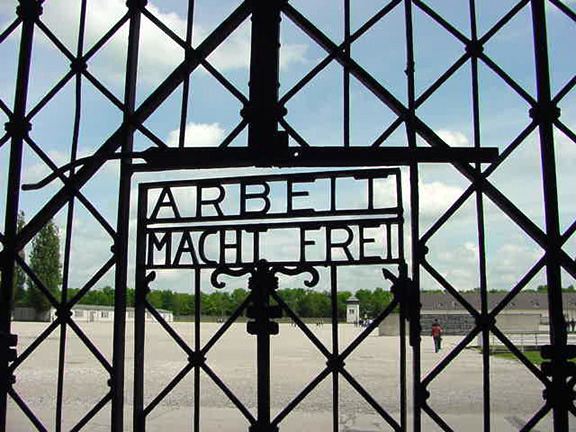 The tour of the Dachau Memorial Site begins at the original gate, completed in June 1936, at the entrance of the former Dachau concentration camp. To get to this gate, visitors walk through the gate house which has a plaque on the wall in honor of the 42nd Infantry Division of the U.S. Seventh Army which participated in the liberation of camp. There is also a plaque in honor of the 20th Armored Division, but no plaque for the 45th Infantry Division. The tour guides ignore these plaques and do not explain why the 45th Division declined to be honored. The tour guides dwell on the "Arbeit Macht Frei" sign on the iron gate, explaining how offensive it was to the political prisoners who had to look at it every day as they marched through the gate to their jobs in the factories just outside the prison enclosure. The gate is original, although the sign is a reconstruction. The tour guides at Dachau explain that the Arbeit Macht Frei sign was intended as a cruel insult to the prisoners who had to work with no hope of freedom because the official Nazi policy was "extermination through work." Actually, there were many prisoners released from the camp as this photo shows. Visitors are told by some of the tour guides that the SS guards sadistically taunted incoming prisoners by telling them that there was only one way out of the camp - through the chimney. The expression "through the chimney" was used by the prisoners at Auschwitz, but it didn't apply to Dachau, which was a camp for rehabilitation and re-education from which many prisoners were released. Prisoners who had been released and were arrested a second time wore badges with a bar over a triangle to identify them as a second timer.  Tourists learn about the medical experiments that were conducted on the prisoners at Dachau. What they are not told is that the medical experiments for the Luftwaffe were done on prisoners who had been classified as "professional criminals" and a few volunteers. There is no mention of the fact that America conducted similar experiments and also confiscated the results of the German experiments. Some of the German doctors who did medical experiments on prisoners at Dachau were brought to America to work on experiments for the U.S. Air Force. In one of the displays in the Museum at Dachau is a box that was used to hold mosquitoes for the malaria experiments that were done at Dachau, using the Catholic priests in the camp as guinea pigs. There were only a few Jews who were imprisoned in the main Dachau camp before 1938 and most of them were released after they had been "rehabilitated." The majority of the 10,911 German Jews, who were taken into "protective custody" in November 1938 and sent to Dachau, were released within a few weeks after they promised to leave Germany within six months. Starting in February 1942, the European Jews who came under the control of the Nazis were all sent to camps in what is now Poland, not to Dachau. To say that Dachau was one of the locations where the Nazis carried out the "Final Solution to the Jewish Question" is incorrect, although some of the tour guides mistakenly tell visitors that Dachau was a "death camp" where Jews were gassed, or an "extermination camp" where Jews were worked to death. The last Dachau roll call showed that there were 67,649 prisoners in the main camp and all of the Dachau sub-camps on April 26, 1945 and that 22,100 of them were Jewish, while 43,401 were Catholic. From their tour guides, visitors learn that one third of the prisoners at Dachau were Jewish. They mistakenly interpret this to mean that one third of the inmates who were imprisoned in the main Dachau camp during its 12 years of existence were Jewish, not that one third of the prisoners counted in the main camp and all the sub-camps, during the last roll call, were Jewish. 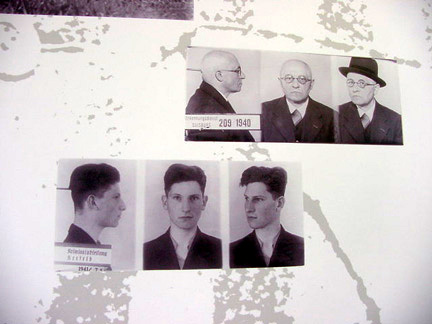 Most of the 2,539 Jews who were in the main camp when it was liberated had only arrived from the Dachau sub-camps within the previous two to four weeks and a few had arrived only the day before they were liberated by the Americans. Other Jews at Dachau when the camp was liberated had been brought to the camp in the summer of 1944 when three ghettos in Lithuania were closed. As the tour guide describes the horrible conditions in the camp, the typical tourist envisions the suffering of these innocent Jews, not realizing that the majority of the Dachau prisoners were Catholics, including 2,579 Catholic priests. 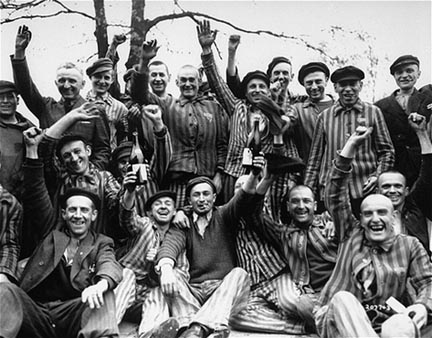 The largest group of prisoners at Dachau were the 9,200 Polish Catholic civilians who continued to fight as partisans after Poland was conquered. As illegal combatants under the 1929 Geneva Convention, these Resistance fighters could have been legally executed, but were instead sent to Dachau and allowed to live. 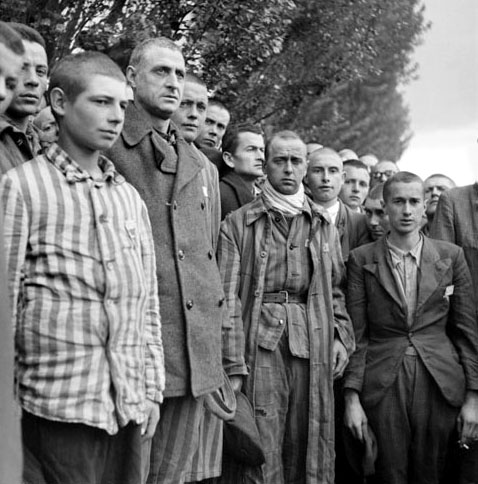 The Nazis referred to the French Resistance fighters as terrorists, but they were not treated like the terrorists in Guantanamo Bay, the American prison for captured insurgents, where prisoners shuffle around, shackled hand and foot, with nothing to do all day. The Catholic cross, shown in the photo below, that was put up on the roll call square at Dachau by the Polish partisans, after the camp was liberated, has long since been removed, but there is now a Catholic church at the north end of the Dachau Memorial Site. 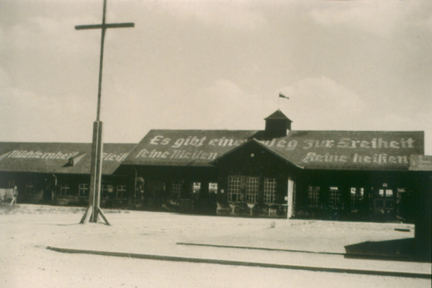 The Nazi slogan on the roof of the present Museum building, shown in the photo above, was removed long ago. The English translation of the slogan is: "There is one road to freedom. Its milestones are: Obedience, Diligence, Honesty, Orderliness, Cleanliness, Sobriety, Truthfulness, Self-Sacrifice, and Love of the Fatherland." Like the sign on the gate, "Arbeit Macht Frei," this slogan was offensive to the Dachau prisoners who did not share the Nazi ideals. What visitors see at Dachau is strictly a memorial in honor of the victims of the Nazis, not a history Museum that tells the whole story. Everything is presented from the prisoner's point of view. The perpetrators do not get equal time. Nothing is presented at Dachau that could possibly show the Nazis in a favorable light or cause visitors to have sympathy for the German people. No Nazi artifacts are displayed.  The Dachau Memorial Site was set up in 1965 by former political prisoners who were members of the International Committee of Dachau when the camp was liberated. These prisoners were anti-Nazi Resistance fighters from Belgium, France, Holland, Czechoslovakia, Norway and Albania or captured British SOE agents who had fought with the French Resistance. The information that is given to tourists today is based on the testimony of the International Committee members and the testimony of the Jews who had survived Auschwitz and other camps before being brought to work in the Dachau sub-camps. International Monument & Unknown PrisonerDachau MemorialsGas chamberDisinfection Chambers & OvensDachau Museum & BunkerRefugee Camp at DachauEntrance to Memorial SiteBack to Dachau Concentration CampBack to Table of ContentsHomeThis page was last updated on September 22, 2010 |